There are 26 different types of turtles in Louisiana, 20 of which are native to the state.
These range from Box turtles, Cooters, snapping turtles, and even Diamondback terrapins. Geographically they are spread across the state in various parts.
There is also 1 species of tortoise native to Louisiana which is the Gopher tortoise. Unfortunately, this vulnerable terrestrial species is in decline.
There are also 5 species of sea turtles that can be seen in the waters off the coasts of Louisiana.
These include Green Sea turtles, Hawksbill Sea turtles, Leatherback and Loggerhead sea turtles, and Kemp’s Ridley sea turtles.
Here is our comprehensive guide to the native turtles in Louisiana.
Quick Reference Section
- Ornate Box Turtle
- Tree-toed Box Turtle
- Chicken Turtle
- Eastern River Cooter
- Mississippi Diamondback Terrapin
- Mississippi Map Turtle
- Ouachita Map Turtle
- Pearl River Map Turtle
- Ringed Map Turtle
- Sabine Map Turtle
- Mississippi Mud Turtle
- Common Musk Turtle
- Razor-backed Musk Turtle
- Stripe-necked Musk Turtle
- Southern Painted Turtle
- Red-eared Slider
- Alligator Snapping Turtle
- Common Snapping Turtle
- Smooth Softshell Turtle
- Spiny Softshell Turtle
- Gopher Tortoise
- Green Sea Turtle
- Hawksbill Sea Turtle
- Kemp’s Ridley Sea Turtle
- Leatherback Turtle
- Loggerhead Sea Turtle
Turtles in Louisiana
1. Ornate Box Turtle
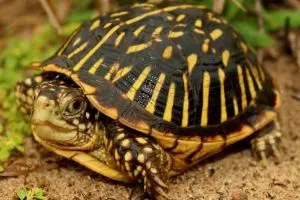
- Experience Level: Intermediate to Expert
- Family: Emydidae
- Scientific Name: Terrapine Ornata
- Adult Size: Between 4 and 5 inches
- Lifespan: Up to 28 years in captivity, up to 40 years in the wild
- Average price range: Between $130 and $450
- Recommended books: Box Turtles (Complete Herp Care) by Tess Cook
These colorful turtles have distinctive patterning on their shells, sporting a series of yellow to orange stripes. Their bodies have light-colored speckles on their skin. Ornate box turtles are classified as threatened in Louisiana.
Ornate Box turtles are mainly found in Louisiana’s southwestern areas, but there are a few scattered populations elsewhere in the state.
Their preferred habitats are open, grassy areas.
These turtles are active during the day and forage for food. They are mostly carnivorous and eat earthworms, insects, and occasionally carrion. They will also eat plants such as berries or cacti.
See our Ornate Box Turtle article for more.
2. Three-toed Box Turtle

- Experience Level: Beginner
- Family: Emydidae
- Scientific Name: Terrapene Carolina Triunguis
- Adult Size: Between 5 and 7 inches
- Lifespan: Between 50 and 100 years
- Average price range: Between $250 and $450
- Recommended books: Box Turtles (Complete Herp Care) by Tess Cook
A subspecies of the Eastern Box turtle, Three-toed Box turtles are a widespread species across Louisiana.
The main habitats for Three-toed Box turtles are woodlands and other grassland areas such as meadows.
Three-toed Box turtles have high domed carapaces which are usually brown or olive in color.
As their name implies, they have three claws on their hind legs rather than four. Their plastrons are yellowish in color.
These turtles are mainly terrestrial and roam around on land in search of food.
Three-toed Box turtles are omnivores will eat fish and invertebrates as well as plants.
See our Three-toed Box Turtle article for more.
3. Chicken Turtle
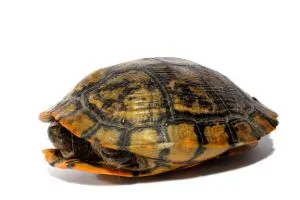
- Experience Level: Intermediate
- Family: Emydidae
- Scientific Name: Deirochelys Reticularia
- Adult Size: Between 4 and 10 inches
- Lifespan: Between 15 and 30 years
- Average price range: Between $130 and $200
- Where to buy: theturtlesource.com
Chicken turtles are a semi-aquatic species that have long, striped necks and oval-shaped shells. Coloring ranges from brown to olive ringed with yellow, with patterns that resemble a net.
Two subspecies of Chicken turtle are native to Louisiana; the Eastern Chicken turtle (Deirochelys reticularia reticularia) and the Western Chicken turtle (Deirochelys reticularia miaria).
They are mainly found in the southwest of Louisiana but can be seen occasionally in other areas.
Chicken turtles are omnivores who mainly feed on crustaceans, fish, and invertebrates as well as plants.
They mainly inhabit areas of still water.
See our Chicken Turtle article for more.
4. Eastern River Cooter
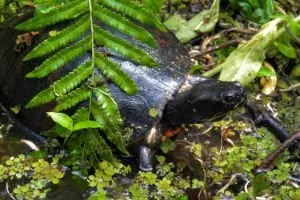
- Experience Level: Beginner to Intermediate
- Family: Emydidae
- Scientific Name: Pseudemys Concinna Concinna
- Adult Size: Between 8 and 12 inches
- Lifespan: Between 20 and 40 years
- Average price range: $20 to $50
- Recommended books: Aquatic Turtles: Sliders, Cooters, Painted, and Map Turtles R.D. Bartlett
Eastern River Cooters are freshwater semi-aquatic turtles that have slightly domed shells ranging from brown to olive.
Their shells and heads have beautiful yellowish markings, while their plastrons are also yellow.
These evasive turtles are found across Louisiana and can breathe underwater.
They can sometimes be seen basking on rocks or logs at the edge of the water, but are notoriously difficult to capture.
Eastern River Cooters are mainly herbivores, preferring to eat vegetation and fruits rather than meat such as fish or insects.
They can be found in many areas of moving water such as rivers or streams.
5. Mississippi Diamondback Terrapin
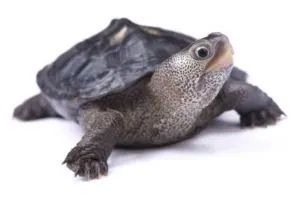
- Experience Level: Beginner to Intermediate
- Family: Emydidae
- Scientific Name: Malaclemys Terrapin Pileata
- Adult Size: 4 ½ to 5 ½ inches (Males) and 6 to 9 inches (Females)
- Lifespan: Between 25 and 40 years
- Average price range: Between $250 to $300
- Recommended books: Map Turtles and Diamondback Terrapins by W.P. Mara
The Mississippi Diamond-backed Terrapin is an aquatic species favoring coastal counties of Louisiana.
They are a subspecies of the Diamond-backed Terrapin.
They can often be seen swimming in the water with their heads poking out, similar to periscopes.
Diamond-backed terrapins have wedge-shaped shells that range from brown or gray to yellow and even black.
Their scutes are ridged and patterned with concentric rings, giving the carapace a sculpted appearance.
These terrapins feed on crustaceans, mollusks, and other invertebrates as well as shellfish such as clams or winkles. They will also occasionally eat vegetation.
See our Diamondback Terrapin care sheet for more.
6. Mississippi Map Turtle
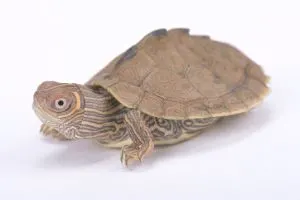
- Experience Level: Beginner
- Family: Emydidae
- Scientific Name: Graptemys Pseudogeographica Kohnii
- Adult Size: Between 3 ½ and 10 ½ inches
- Lifespan: Between 30 and 50 years
- Average price range: Between $15 and $150
- Recommended books: Map Turtles and Diamondback Terrapins by W.P. Mara
The Mississippi Map turtle is a subspecies of the False Map turtle native to Louisiana.
They usually dwell in the Mississippi River areas of Louisiana in central and northern counties.
Mississippi Map turtles have dark shells, often brown or black, and have contour-like yellow markings.
As the turtle ages, this pattern gets fainter. Most adults have a sharp keel running the length of their shells.
These turtles rarely travel far from the water and like to bask on outcrops over the water surface.
This species is omnivorous and eats aquatic invertebrates, crayfish, and aquatic plants.
7. Ouachita Map Turtle

- Experience Level: Beginner
- Family: Emydidae
- Scientific Name: Graptemys Ouachitensis
- Adult Size: 3 ½ to 5 inches for males, 5 to 10 inches for females
- Lifespan: Between 15 and 20 years
- Average price range: Between $40 and $100
- Where to buy: theturtlesource.com
- Recommended books: Map Turtles and Diamondback Terrapins by W.P. Mara
Ouachita Map turtles can be distinguished from other Map turtles by the large yellow spots on the sides of their heads.
Males have a prominent keel protruding from their dark green shells.
Ouachita Map turtles are found mainly along the Atchafalaya, Mississippi, and Red Rivers of Louisiana.
They are active during the day and like to bask. They are easily startled and will jump into the water.
As with many other turtles, Ouachita Map turtles are omnivores.
They don’t eat as much protein as other species in the wild, but still mainly eat mollusks, aquatic larvae, and plants.
8. Pearl River Map Turtle
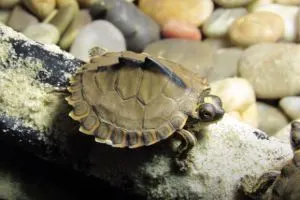
- Experience Level: Intermediate
- Family: Emydidae
- Scientific Name: Graptemys Pearlensis
- Adult Size:3 to 5 inches (Males) and 8 to 10 inches (Females)
- Lifespan: Between 30 and 50 years
- Average price range: Between $180 and $230
- Where to buy: theturtlesource.com
- Recommended books: Map Turtles and Diamondback Terrapins by W.P. Mara
The Pearl River Map turtle is a rare subspecies of Map turtle, seen only in Louisiana and Mississippi.
As their name suggests, these turtles are found mainly in areas around the Pearl River.
The species is under threat due to water pollution, and are an endangered species.
Their shells are usually olive green, with fluted edges marked in yellow.
Like most Map turtles, they have pronounced keels along the ridge of their carapace.
Pearl River Map turtles are omnivorous and will mainly eat invertebrates, crustaceans, and small fish as well as aquatic plants.
9. Ringed Map Turtle

- Experience Level: Intermediate
- Family: Emydidae
- Scientific Name: Graptemys oculifera
- Adult Size: 3 to 5 inches (Males) and 8 to 10 inches (Females)
- Lifespan: Between 30 and 50 years
- Average price range: Between $700 and $1000
- Where to buy: theturtlesource.com (Florida Residents Only)
- Recommended books: Map Turtles and Diamondback Terrapins by W.P. Mara
Ringed Map turtles are a federally threatened subspecies of Map turtle, and are illegal to keep as pets in many states.
In Louisiana, they are mainly confined to a couple of eastern counties near the Pearl River.
These striking turtles have shells ranging from green to yellowish, with several sharp peaks down the center.
They also have beautiful yellow ring-like markings on their carapaces. Their shells have jagged, saw-toothed edges.
Ringed Map turtles are omnivores and mainly eat mollusks and crustaceans as well as aquatic vegetation. They prefer moving water such as rivers.
10. Sabine Map Turtle

- Experience Level: Beginner
- Family: Emydidae
- Scientific Name: Graptemys sabinensis
- Adult Size: 3 to 5 inches (Males) and 8 to 10 inches (Females)
- Lifespan: Between 30 and 50 years
- Average price range: Between $30 and $70
- Recommended books: Map Turtles and Diamondback Terrapins by W.P. Mara
Sabine Map turtles are a subspecies of Map turtles that inhabit western counties of Louisiana.
They prefer moving water such as rivers and streams.
These beautiful little turtles have prominent, black-tipped ridges running down the spine of their brown to olive shells.
Their scutes are covered with swirling contour patterns, similar to a map. Their faces sport yellowish markings and they have yellow to cream plastrons.
Like most other Map turtles, Sabine Map turtles are omnivorous.
They usually feed on mollusks, crustaceans, invertebrates, and small fish as well as plants.
11. Mississippi Mud Turtle
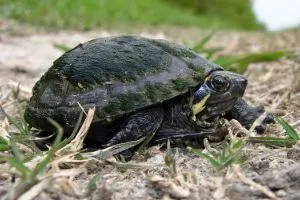
- Experience Level: Beginner
- Family: Kinosternidae
- Scientific Name: Kinosternon Subrubrum Hippocrepis
- Adult Size: Between 3 and 5 inches
- Lifespan: Up to 50 years
- Average price range: $40 to $100
- Recommended books: Map Turtles and Diamondback Terrapins by W.P. Mara
Mississippi Mud turtles are Louisiana’s native subspecies of the Eastern Mud turtle and can be found all across the state.
They like shallow, slow-moving waters, especially swamps, tidal marshes, or bogs.
They are semi-aquatic and often move around on land.
These turtles have smooth, oval-shaped carapaces that range between brown and yellowish in color.
Their shells drop quite sharply at the sides and back, whilst their plastrons are larger than those of their Musk turtle relatives.
Eastern Mud turtles are omnivorous and mainly eat worms, snails, and other mollusks and sometimes fish. They will also eat plants.
12. Common Musk Turtle
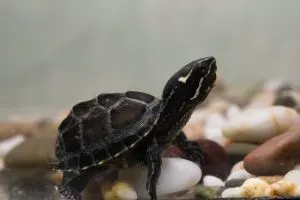
- Experience Level: Intermediate
- Family: Kinosternidae
- Scientific Name: Sternotherus Odoratus
- Other Names: Eastern Musk Turtle
- Adult Size: Between 4 and 5 inches
- Lifespan: 50 years and over
- Average price range: Between $20 and $90
- Where to buy: theturtlesource.com, undergroundreptiles.com
Also known as “Stinkpots” due to the strong smell they can release from their musk glands, Eastern Musk turtles use this ability to protect themselves from predators.
They are widespread across Louisiana.
Eastern Musk turtles have dark, unmarked shells. Their heads are also dark, with yellow lines along their faces.
They prefer permanent bodies of water as well as marshy areas.
An omnivorous species, Eastern Musk turtles hunt for prey by scent. They mainly eat mollusks, crayfish, small fish, and tadpoles.
They aren’t strong swimmers, so do not really chase prey.
13. Razor-backed Musk Turtle
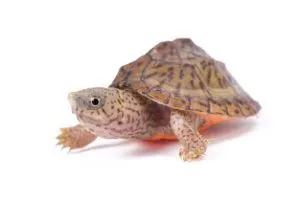
- Experience Level: Beginner
- Family: Kinosternidae
- Scientific Name: Sternotherus Carinatus
- Adult Size: Between 5 and 6 inches
- Lifespan: Between 25 and 50 years
- Average price range: Between $60 and $150
Razor-backed Musk turtles are mainly an aquatic turtle species common across much of Louisiana.
They mainly inhabit slower-moving waters such as ponds and usually hide between aquatic vegetation.
Their shells can vary from black and brown to gray or olive. The scutes look like a series of razor-like humps and are edged in black.
Their brown or gray skin is usually covered in black dots, while black marking lines stretch across the shell.
Razor-backed Musk turtles are carnivorous and mainly eat meat in the form of invertebrates, shellfish, crustaceans, fish, and mollusks.
14. Stripe-necked Musk Turtle

- Experience Level: Intermediate
- Family: Kinosternidae
- Scientific Name: Sternotherus Minor Peltifer
- Adult Size: Between 3 and 4 ½ inches
- Lifespan: Over 50 years
- Average price range: Between $20 and $60
A subspecies of the Loggerhead Musk turtle, Stripe-necked Musk turtles are small, quick aquatic turtles found in counties of Louisiana that border Mississippi.
They usually inhabit ponds and rivers as well as wetlands.
These little turtles have shells that range from brown to tan and sport dark spots.
Their head and skin are usually brown, with prominent yellowish stripe markings running along the head and neck.
Stripe-necked Musk turtles are omnivores who mainly feed on mollusks, crustaceans, insects, and plants.
While underwater, these turtles will walk along the riverbed and can stay submerged for long periods of time.
15. Southern Painted Turtle
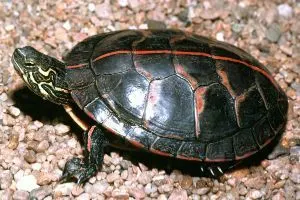
- Experience Level: Beginner
- Family: Emydidae
- Scientific Name: Chrysemys Dorsalis
- Adult Size: Between 5 and 7 inches
- Lifespan: Between 20 and 50 years
- Average price range: Between $70 and $140
- Recommended books: Painted Turtle Pet Owners Guide by Ben Team
Southern Painted turtles are mainly seen in slow-moving waters as well as the floodplains surrounding Louisiana’s main rivers.
They are the smallest subspecies of the Painted turtle.
Southern Painted turtles have dark brown or black smooth shells with an orange or yellow band running down the spine of the carapace.
Their dark skin sports yellow to orange markings.
Like many Painted turtles, their plastrons are yellowish in color.
Mainly a freshwater species, Southern Painted turtles stay near the water and like to bask.
Painted turtles are omnivorous and mainly eat mollusks, frogs, and underwater invertebrates.
16. Red-eared Slider

- Experience Level: Beginner
- Family: Emydidae
- Scientific Name: Trachemys Scripta Elegans
- Adult Size: Between 6 and 8 inches
- Lifespan: Between 20 and 40 years
- Average price range: Between $15 and $50
The Red-eared Slider is one of the most popular species of pet turtle on the market.
This semi-aquatic species is widely seen throughout the whole state of Louisiana.
These turtles like to bask at the water’s edge, and often stack themselves on top of each other! Red-eared Sliders prefer warm, slow-moving waters.
Their omnivorous diet consists of small fish, aquatic invertebrates, and underwater vegetation.
Red Eared Sliders commonly have an olive green shell, with yellowish striped markings on their scales.
Their heads are usually a darker color, with yellow band markings and red patches just behind their eyes.
17. Alligator Snapping Turtle
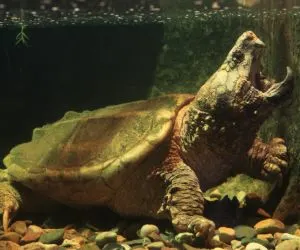
- Experience Level: Intermediate to Expert
- Family: Chelydridae
- Scientific Name: Macroclemys Temmincki
- Adult Size: Between 15 and 26 inches
- Lifespan: Between 60 and 70 years
- Average price range: Between $25 and $60
Alligator Snapping turtles are the largest freshwater species in Louisiana and are instantly recognizable.
They have thick ridged, spiked shells and incredibly strong, beak-like jaws. They are usually dark brown in color.
These mighty turtles are aquatic and live in deep waters like lakes or rivers. They are found across Louisiana but their numbers are decreasing.
They are under review to potentially receive federal protection.
Alligator Snapping turtles are carnivores, and will essentially eat anything they can catch. This includes other species of turtle!
Their strong jaws are capable of crushing their prey.
Check our Alligator Snapping turtle care guide for more on how to care for one as a pet.
18. Common Snapping Turtle
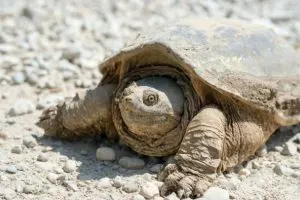
- Experience Level: Intermediate to Expert
- Family: Chelydridae
- Scientific Name: Chelydra Serpentina
- Adult Size: Between 8 and 20 inches
- Lifespan: Between 30 and 50 years
- Average price range: Between $20 and $40
- Recommended books: Snapping Turtle Pet Owners Guide by Ben Team
Common Snappers are large, freshwater turtles that are found in virtually any body of water across Louisiana.
They can be aggressive and will often hiss and bite. They do not bask often, preferring to remain in the water.
Identified by their distinctive hooked “beaks”, Common Snappers usually have dark brown or green shells.
They also have relatively strong claws and long tails that sport saw-toothed ridges.
Common Snappers are nocturnal omnivores, mainly eating fish and other aquatic prey. They also consume underwater vegetation.
There have been some instances of Snappers eating small waterbirds if they get close enough.
19. Smooth Softshell Turtle
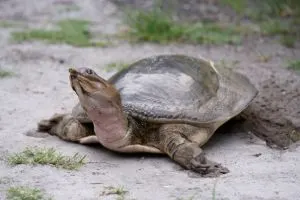
- Experience Level: Intermediate to Expert
- Family: Trionychidae
- Scientific Name: Apalone Mutica
- Adult Size: 4 ½ to 7 inches for males, 6 ½ to 14 inches for females
- Lifespan: 25 years and over
- Average price range: Between $40 and $60
- Where to buy: theturtlesource.com
- Recommended books: Softshell Turtle Owners Guide by Ben Team
Smooth Softshell turtles are found mainly in northern areas of Louisiana.
They look like leathery pancakes and lack a hard carapace to protect themselves.
They are usually brown or gray, with lines running from behind their eyes and snouts.
Two subspecies are found in Louisiana; the Gulf Coast Smooth Softshell (Apalone Mutica Calvata) can be found in the northeast. In central and western areas, the Midland Smooth Softshell (Apalone Mutica Mutica) can be found.
They usually bury themselves in sand in the shallows and sleep like this at night.
They mainly eat insects, but also mollusks and crayfish.
20. Spiny Softshell Turtle
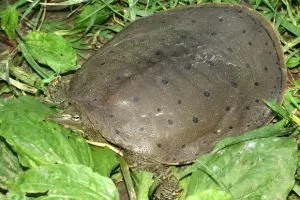
- Experience Level: Intermediate to Expert
- Family: Trionychidae
- Scientific Name: Apalone Spinifera
- Adult Size: 5 to 9 ½ inches for males, 7 to 17 inches for females
- Lifespan: Between 20 and 50 years
- Average price range: Between $70 and $280
- Recommended books: Softshell Turtle Owners Guide by Ben Team
Spiny Softshells have a pancake-like shell with dark circles.
Their skin feels like sandpaper, and they have long, tapered beaks.
Three subspecies of Spiny Softshell are native to Louisiana.
Eastern Spiny Softshells (Apalone Spinifera Spinifera) inhabit northern counties, while the Gulf Coast Spiny Softshell (Apalone Spinifera Aspera) is found in the southeast.
The Pallid Spiny Softshell (Apalone Spinifera Pallida) dwells in southwest and northern areas.
These turtles are fast swimmers.
They are carnivores and will feed on any crustaceans, invertebrates, and mollusks they can find. They also occasionally eat aquatic plants.
One species of tortoise is also native to Louisiana; the Gopher tortoise.
This species is considered vulnerable and is also a federally threatened species in Louisiana.
While it is illegal in many states to own one, here are some facts about the Gopher tortoise.
Tortoises In Louisiana
There is only one tortoise native to Louisiana which is shown below.
21. Gopher Tortoise

- Family: Testudinidae
- Scientific Name: Gopherus Polyphemus
- Adult Size: Between 10 and 15 inches
- Weight: Between 10 and 20 pounds
- Lifespan: Between 40 and 60 years in the wild
- Conservation Status: Vulnerable
- Habitat: Burrows which they dig in grasslands
- Clutch Size: Up to 25 eggs
- Food: Herbivores – plants fruits and berries
- Appearance: Large tortoises with dark brown to gray shells. Elephant-like hind-legs.
Check out our Gopher Tortoise page for more information.
Sea Turtles In Louisiana
There are also five species of sea turtles that visit the coastal areas of Louisiana.
These are the Green Sea turtle, Hawksbill Sea turtle, Leatherback and Loggerhead sea turtles, and the Kemp’s Ridley sea turtle.
All of these species are endangered. Although they cannot be kept as pets, we have provided a quick overview of each species below.
22. Green Sea Turtle

- Family: Cheloniidae
- Scientific Name: Chelonia Mydas
- Adult Size: Between 3 and 4 feet
- Weight: Between 300 and 400 lbs
- Lifespan: Between 80 and 100 years
- Conservation Status: Endangered
- Habitat: Bays and shores along coastlines and open ocean waters, seen during summer months.
- Clutch Size: Around 110 to 115 eggs, with 2 to 5 clutches per breeding season.
- Food: Mostly herbivores, eating algae, sea grasses and seaweed.
- Appearance: Smooth green to brown shells shaped like hearts, edged in yellow. Cream-colored scaly skin with shades of green.
Head to our Green Sea Turtles page for more information.
23. Hawksbill Sea Turtle

- Family: Cheloniidae
- Scientific Name: Eretmochelys Imbricata
- Adult Size: Between 30 and 35 inches
- Weight: Between 100 to 155 lbs
- Lifespan: Between 30 and 50 years
- Conservation Status: Critically Endangered
- Habitat: Shallow coastal areas of rocky or tropical waters, reefs, and estuaries.
- Clutch Size: Between 140 to 200 eggs, about 4 clutches per breeding season.
- Food: Omnivores, mainly consume crustaceans, mollusks, and algae.
- Appearance: Prominent, beak-shaped mouths (like a hawk), oval shells in shades of amber with unique markings.
Flippers also have claws at their “elbows”.
Check out our Hawksbill Sea turtle page for more.
24. Kemp’s Ridley Sea Turtle

- Family: Cheloniidae
- Scientific Name: Lepidochelys Kempii
- Adult Size: Around 25 inches
- Weight: Between 75 and 100 lbs
- Lifespan: Around 30 years
- Conservation Status: Critically Endangered
- Habitat: Sandy or muddy coastlines with shallow waters.
- Clutch Size: Between 100 and 110 eggs, 2 to 3 clutches per breeding season.
- Food: Crustaceans, shellfish
- Appearance: Slightly hooked beaks, triangle-shaped heads. Green to gray round shells.
Muted cream or yellow plastrons and undersides.
Visit our Ridley sea turtle page for more information.
25. Leatherback Turtle

- Family: Dermochelyidea
- Scientific Name: Dermochelys Coriacea
- Adult Size: Between 6 and 7 feet
- Weight: Between 1200 and 1450 lbs
- Lifespan: Around 30 years
- Conservation Status: Vulnerable
- Habitat: Warm waters, mainly shallow, calm bays or lagoons. Nests are common on sandy beaches.
- Clutch Size: Between 100 and 110 eggs
- Food: Jellyfish is the staple of their diet, but they will also eat other sea creatures.
- Appearance: Their large carapaces are soft, and unique among sea turtles, with prominent ridges all the way down.
Colors vary between black and dark gray.
For more information, see our Leatherback sea turtle page.
26. Loggerhead Sea Turtle

- Family: Cheloniidae
- Scientific Name: Caretta caretta
- Adult Size: Between 30 and 45 inches
- Weight: Approximately 155 pounds
- Lifespan: Between 70 and 80 years
- Conservation Status: Endangered
- Habitat: Coastal regions, mainly shallow bays. Prefer sub-tropical waters. Sandy Ocean beaches for nesting.
- Clutch Size: Between 100 and 125 eggs, 4 to 5 clutches per breeding season.
- Food: Carnivorous, mainly eating shellfish, mollusks, and crustaceans.
- Appearance: Largest hard-shelled turtles with a reddish-brown carapace and large heads. Undersides are cream to yellowish. Long powerful flippers.
Check out our Loggerhead sea turtle page for more information.
Conclusion
In this extensive list, we have covered the 20 native species of turtles in Louisiana.
We’ve examined groups like Map turtles to Softshell turtles, and Mud turtles to Box turtles.
Louisiana is home to a diverse range of interesting species!
We’ve also taken a quick look at the Gopher tortoise, a vulnerable terrestrial species native to Louisiana.
We also looked at 5 species of sea turtles that visit the coastlines of Louisiana.
Did you enjoy our Louisiana list? If so, then feel free to comment below whether you are looking to purchase a turtle or are just a herpetology enthusiast!
Other nearby states
